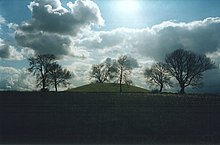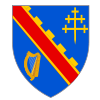Navan Fort
- Not to be confused with the town of Navan in County Meath.
 Navan Fort or Eamhain Mhacha | |
| Location | County Armagh, Northern Ireland |
|---|---|
Navan Fort (Old Irish: Emaın Macha ([ˈeṽənʲ ˈṽaxə]), Modern Irish: Eamhain Mhacha ([ˈaw̃nʲ ˈw̃axə])) is an ancient monument in County Armagh, Northern Ireland. According to tradition it was one of the great royal sites of pre-Christian Gaelic Ireland and the capital of the Ulaid. Severed heads of their enemies were said to be kept here. It is a large circular enclosure—marked by a bank and ditch—with a circular mound and the remains of a ring barrow in the middle. Archeological investigations show that there were once buildings on the site, including a huge roundhouse-like structure. The site is believed to have had a pagan ceremonial purpose. According to the Oxford Dictionary of Celtic Mythology, "the [Eamhain Mhacha] of myth and legend is a far grander and mysterious place than archeological excavation supports".[1]
The name Eamhain Mhacha is thought to mean "the pair of Macha" or "the twins of Macha". 'Navan' is an anglicisation of the Irish An Eamhain.
Location and description

The site is a State Care Historic Monument in the townland of Navan, in Armagh City and District Council area. It is on a low hill about 1.6 miles (2.6 km) west of Armagh (at grid ref. area H847 452).[2] The site consists of a circular enclosure 250 metres (820 ft) in diameter, marked by a bank and ditch. Oddly, the ditch is on the inside, suggesting it was not built for defence.
Inside the enclosure two monuments are visible. Off-centre to the north-west is an earthen mound 40 metres (130 ft) in diameter and 6 metres (20 ft) high. Off-centre to the south-east is the circular impression of a ring-barrow, the flattened remains of a late prehistoric ceremonial or burial monument, about 30 metres (100 ft) in diameter.[3]
Archaeological excavations have revealed that the construction of the 40 metre mound dates to 95 BC (securely dated by dendrochronology).[3] A roundhouse-like structure consisting of four concentric rings of posts around a central oak trunk was built, its entrance facing west (prehistoric houses invariably face east, towards the sunrise). The floor of the building was covered with stones arranged in radial segments, and the whole edifice was deliberately burnt down before being covered in a mound of earth and turf (there is archaeological evidence for similar repeated building and burning of Tara and Dún Ailinne).[3] The bank and ditch that mark the enclosure were made at the same time.
No firm date can be assigned to the ring-barrow, but excavations and geophysical surveys have revealed the remains of a figure-of-eight shaped wooden building underneath. The larger ring of the figure-of-eight was 30 metres (100 ft) in diameter, the smaller about 20 metres (65 ft). The building had been rebuilt twice. Similar, slightly smaller structures, each with a central hearth, were found under the 40 metre mound. Artifacts found in these layers show they were inhabited in the late Bronze Age and early Iron Age (about 600 to at least 250 BC). Perhaps the most unusual item found in these layers was the skull of a Barbary macaque.[4]
An earlier Bronze Age structure, a circular ditch surrounding the mound, 45 metres (150 ft) in diameter, 5 metres (16 ft) wide and 1 metres (3 ft) deep, was also found, and flint tools and shards of pottery show activity at the site in the Neolithic (c. 4000 to 2500 BC).
Until 1985, the site was threatened by the expansion of a nearby limestone quarry. Due mostly to the efforts of the activist group Friends of Navan, a public inquiry held that year halted further quarrying, and recommended that the site be developed for tourism. A visitor centre, featuring artefacts and audio-visual exhibitions, was opened in 1993, but closed in 2001 for lack of funds.[5] It reopened on a seasonal basis in 2005 after the site was bought by Armagh City and District Council.
Other significant prehistoric sites nearby include Haughey's Fort, an earlier Bronze Age hill fort two-thirds of a mile (1 km) to the west; the King's Stables, a manmade pool also dating to the Bronze Age; and Loughnashade, a natural lake which has yielded Iron Age artefacts.
In Irish mythology

According to Irish mythology and historical tradition it was the capital of the Ulaidh, the people who gave their name to the province of Ulster. It was supposedly founded by the goddess Macha in the 7th or 5th century BC, and was the seat of Conchobar mac Nessa in the tales of the Ulster Cycle. Conchobar is said to have had three houses at Eamhain Mhacha:
- the Cróeb Ruad ("Dull Red Branch", whence derives the nearby townland of Creeveroe) where the king sat;
- the Cróeb Derg ("Bright Red Branch"), where trophies of battle were kept, and
- the Téte Brecc ("Speckled Hoard") where the warriors' weapons were stored.
Many of the most famous names in Irish mythology are associated with Eamhain Mhacha and the Red Branch warriors.
- Amergin the poet
- Cú Chulainn, the great warrior
- Emer, his strong-willed and beautiful bride
- Conall Cernach (Conall the Victorious), his foster-brother and close friend
- Lóegaire, another warrior
- Conchobar mac Nessa, king of Ulster
- Cathbad, the chief druid
- Fergus mac Róich, another great warrior and king
- Deirdre of the Sorrows, the most beautiful woman in Ireland, and Naoise, her brave lover
- Leabharcham, the wise woman
In mythology, the name Eamhain Mhacha is variously explained as "Macha's twins" (so named because Macha gave birth to twins there after being forced to compete in a chariot-race) or "Macha's neck-brooch" (so named because Macha marked out the bounds of the site with her brooch). The Annals of the Four Masters record that it was abandoned after it was burnt by the Three Collas in 331 AD, after they had defeated Fergus Foga, king of Ulster, in battle at Achadh Leithdheirg.
In popular culture

Eamhain Mhacha is the name of a traditional Irish music band formed in 2008.[6] Irish heavy metal band Waylander also has a song called "Emain Macha" on their 1998 album Reawakening Pride Once Lost.
"Emain Macha" is the name of a place in the computer games Dark Age of Camelot,[7] Mabinogi and The Bard's Tale.
See also
- An sluagh sidhe so i nEamhuin? ("Is this a fairy host in Eamhain Mhacha?") – an Irish poem dated to the late 16th century.
References
- Notes
- ^ Oxford Dictionary of Celtic Mythology, ed. James MacKillop, entry for Emain Macha
- ^ "Navan Fort" (PDF). Environment and Heritage Service NI – State Care Historic Monuments. Retrieved 3 December 2007.
- ^ http://irisharchaeology.ie/2014/05/a-barbary-ape-skull-from-navan-fort-co-armagh/
- ^ Bender, Barabara (2001). "The Politics of the Past: Emain Macha (Navan), Northern Ireland". In Layton, Robert (ed.). Destruction and Conservation of Cultural Property. Routledge. pp. 199–209. ISBN 0-415-21695-8.
{{cite book}}: Cite has empty unknown parameters:|month=and|coauthors=(help) - ^ [1]
- ^ Shadows Edge – DAOC – Emain – Dark Age of Camelot New Frontiers Map
- Sources
- Ronald Hutton, Pagan Religions of the Ancient British Isles, 1991
Texts
External links
- Navan Centre & Fort – Official site at Visit Armagh
- Navan Fort – information at Northern Ireland Environment Agency
- Navan Research Group – official website
- "High Hopes for NI Tourist Centre" (BBC News)
- BBC Timelines
- Environment and Heritage Service page on Navan Fort, with photos
- Geography in Action: Navan Fort



